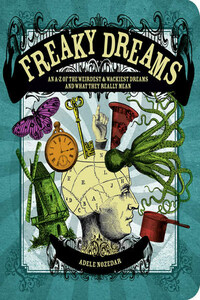An A-Z of the Weirdest and Wackiest Dreams and what They Really Mean
Introduction - The Land of Nod
How to Remember Your Dreams
The A to Z Guide of Dream Symbols
Cheese Dreams: Does Food Make Freaky Dreams…Freakier?
Digital Dreams
The Award for “Most Popular Dream” Goes To…
Lucid Dreaming: The Art of Controlling Your Dreams
Anxiety Dreams
Recurring Dreams
What Exactly is a Nightmare?
Notes
About the Author
Other Books by Adele Nozedar
Thank You
Copyright
About the Publisher
I dreamed I was in the kitchen making a sandwich.
It was the weirdest dream I’ve ever had.
When I started researching this book, I asked people to tell me about their dreams; specifically, I was after the weirdest, the freakiest, the most disjointed examples, the ones that really do defy analysis. And the two-line quote above, was possibly one of the oddest.
It seems odd because it’s so normal.
After all, it’s in the nature of a dream that it’s weird and freaky. If you’re describing a dream to someone, is it likely that you’d ever say, “Oh my, I’ve got to tell you about the REALLY NORMAL dream I had last night!”? Nope!
Despite centuries of research that’s still continuing, there’s still so much about dreams, and indeed sleep, which remains a mystery.
Mankind has traveled into the deepest depths of the oceans. We’ve set foot on the moon. We’ve sent probes to pick up pebbles from Mars, and we’ve taken photographs in the unfathomable vastness of space. And yet we still don’t know quite what happens, or where we go to, every night when we toddle off to bed, close our eyes, and sleep.
For example, here’s something that’s very puzzling.
If you’ve ever watched someone sleeping, you might have noticed their eyeballs moving swiftly back and forth under the lids. This is called Rapid Eye Movement (REM), and it happens when the sleeper is dreaming. Dreams are our way of processing the events of the day, incidents in our lives, and all sorts of physical and philosophical phenomena.
The duck-billed platypus, of all animals on earth, shows the most extreme incidence of REM.
What is the platypus processing? What sort of anxieties could exist in that little platypus mind? We’ll never know. Another mystery. In fact, to be fair, scientists aren’t even certain that the platypus is even dreaming.
BUT WHAT IF IT IS?
The great thing about dreams is that anything can happen, any kind of surreal scenario is allowed to play out, no holds barred. In your dream world, you can be a superhero or a god, an animal, a tramp, a teapot. Dreams allow us to tap into an internal imaginary world that is as vast as that external universe that the space probes poke around in. The possibility of a fabulous dream is enough to make bedtime seem like a really fun proposition.
HOW TO REMEMBER YOUR DREAMS
The dream is the small hidden door in the deepest and most intimate sanctum of the soul, which opens into that primeval cosmic night that was soul long before there was a conscious ego and will be soul far beyond what a conscious ego could ever reach.
-Carl Jung, The Meaning of Psychology for Modern Man, 1934
We’re presupposing that you already know how to sleep, so let’s get straight to the juicy stuff. Some of us really do believe that we never dream, or maybe that we dream only very rarely.
That’s not true. Everyone dreams.
What’s more, we each have several episodes of dreaming throughout the night. They occur primarily during the period of REM described above, during which our most intense dreams take place, but there’s also a phase called Non-Rapid Eye Movement (NREM) during which dreams might happen—or they might not..
So, if we all dream, then why don’t we all remember them?
Some scientists have speculated that we don’t remember them simply because it wouldn’t be healthy to do so. After all, if we had to think not only of all the stuff that happens every day in our waking lives AND then think about our dreams, we’d probably go mad. There also needs to be a clear distinction between dreams and waking reality. For example, to dream of flinging yourself from the top of a moving train and then finding that you can fly to safety is fine, but to try the same thing in real life wouldn’t be very clever. Dreams are by their very nature full of absurd scenarios and impossible situations which would simply never happen in our waking lives.
Always with the adjunct “Safety First,” then, here are some tips on how to remember your dreams.
DECIDE TO REMEMBER YOUR DREAMS
Start out by making the decision that you do actually want to be able to recall your dreams. Tell yourself that this is what you want. Repeat this mantra several times a day:
I will remember my dreams.
I will remember my dreams.
I will remember my dreams.
BREAK UP YOUR SLEEP PATTERN
If you can, aim to break up your sleep pattern. We remember our dreams usually when we’ve been woken up in the middle of, or immediately after, a dream episode.
You might have a dedicated friend who will time how long it take between you falling asleep until the REM pattern starts. You could try setting an alarm to wake yourself when this happens. Otherwise, try setting the alarm at random times. We sleep in 90-minute cycles, so if you don’t have to get up at the crack of dawn the next day, you could set an alarm clock to go off at 90-minute intervals throughout the night.










